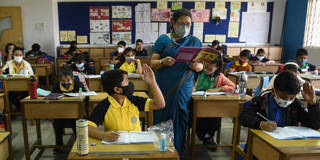The COVID-19 pandemic has had a devastating effect on the learning outcomes of millions of pupils across India, reversing years of incremental progress. But a recent visit to a school for poor children in a remote rural district revealed an unexpected beacon of hope in an experimental but promising educational model.
NEW DELHI – The world has reached a major turning point. As artificial intelligence increasingly edges out traditional labor, it becomes clear that the future belongs to countries that can adapt to the changing nature of work. But adaptability requires an education system that nurtures creativity. This is particularly true in countries like India, where the growing digital divide threatens to widen existing inequalities.

NEW DELHI – The world has reached a major turning point. As artificial intelligence increasingly edges out traditional labor, it becomes clear that the future belongs to countries that can adapt to the changing nature of work. But adaptability requires an education system that nurtures creativity. This is particularly true in countries like India, where the growing digital divide threatens to widen existing inequalities.